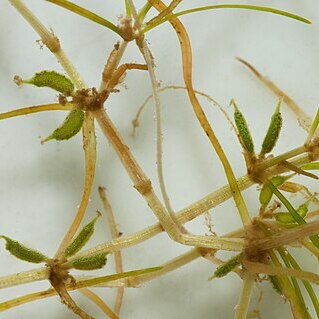Submerged aquatic herb forming dense tangled mats, resembling fine grass; rhizome thin, branching freely; stems erect, to 50 cm long.. Leaves 1–3 per node, ternate, opposite or alternate, greenish brown, subterete or linear, 1.2–5 cm long, 0.5–2 mm wide, at base with or without tubular, membranous sheath, at apex attenuate; axillary scales minute.. Flowers almost consistently 1 ♂ and a cluster of ♀ together at each pseudowhorl or distally sometimes ♂ alone, each surrounded by a membranous sheath; staminate flower of a single stamen, filament elongating at anthesis, to 2 cm long, anther 4–8-locular, at base with small axial protuberance, at apex with gland; pollen glandular; pistillate flowers (1–)4–5(–8) in pseudo-umbel, when immature enclosed in cupular sheath, peduncle 1–5 mm long, carpel ovoid, stipitate, stigma spoon-shaped but rapidly disintegrating.. Fruit reniform, 2–6 mm long, with a keel and protuberances on convex and sometimes concave sides, stipitate, with persistent style.
Annual, occasionally perennial herb, monoecious, hydrophyte, forming dense mats resembling fine grass, height depending on depth of water; rhizome thin, branching; stem erect. Leaves 1-3 per node, linear, 20-50 x 1-2 mm, tapering above; sheaths tubular, membranous. Flowers unisexual, aggregated in axils of leaf whorls, surrounded by sheaths. Male flower with solitary filaments up to 20 mm long; anthers 4-8 locular, with glandular apical knob and small pustule at base; pollen globular. Female flowers arranged in pseudo-umbel; carpel ovoid, stipitate; style tubular; stigma spathulate. Flowering time Nov.-May.
Submerged, annual or perennial herb, brittle, forming dense mats resembling fine grass. Stems erect, thin, up to 500 mm long. Leaves with basal leaf sheaths free from leaf, mostly opposite, upper ones clustered in pseudowhorls. Flowers: inflorescence umbellate; green; Oct.-May. Fruit a bean-shaped drupelet, 2 mm long, crested and knobbed on convex side, apex pin-shaped with style and stigma base being persistent.
Stems 3-20(-50) cm, 0.3-0.5 mm in diam. Leaves 2-10 cm × 0.3-0.5 mm, apex acuminate; sheaths usually free from leaf base, stipuliform, membranous, evanescent. Anthers 0.6-1 mm; filaments ca. 3 mm. Carpels usually 3 or 4. Fruitlet often curved, reniform to semilunate, 2-2.5 mm, abaxially remotely cristate-dentate, long beaked. Fl. and fr. spring to autumn. 2n = 12, 24, 28, 32, 36.
Rhizome scarcely differentiated from the very slender and fragile leafy stem; lvs 3–10 cm × 0.5 mm, 1-nerved, or partly 3-nerved in robust plants; achenes keeled on both the outer and inner sides, the body 2–3 mm, the style 1 mm; 2n=24, 48, 32, 36. In fresh (often eutrophic) or brackish water almost throughout N. Amer., and widespread in the Old World.
Herbs entirely submersed. Stems to 50 cm ´ 0.2----0.6 mm. Leaves 3.5--4.2 cm ´ 0.2--1 mm, apex acute. Staminate flowers: filament 1.5--2 mm, connective prolonged into blunt tip 0.1 mm. Pistillate flowers: pistils 4--5; style 0.4--0.7 mm. Fruits 1.7--2.8 ´ 0.6--0.9 mm; rostrum 0.7--2 mm; podogyne 0.1--1.5 mm; pedicel 0.3--1.2 mm.
Submerged annual herb, brittle, forming dense mats resembling fine grass. Stems erect, thin, up to 500 mm long. Leaves ternate or opposite. Inflorescence umbellate. Flowers green.
Aquatic, mat-forming, brittle annual or perennial, up to 0.5 m long, forming submerged grass-like turf. Leaves opposite or upper ones ternate, linear. Flowers inconspicuous.
Submerged aquatic, monoecious, annual or perennial, weakly rhizomatous. Leaves mostly opposite, 2–7 cm long,
Submerged, mat-forming annual to 50 cm. Leaves opposite or ternate, linear. Flowers inconspicuous.


